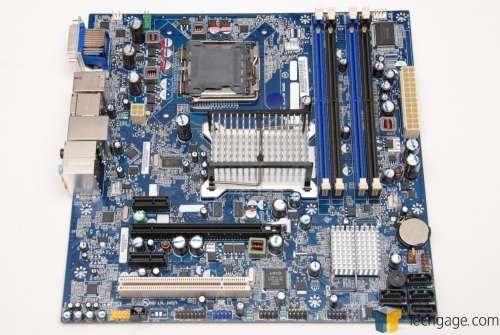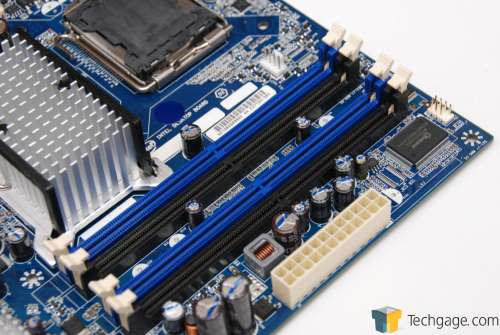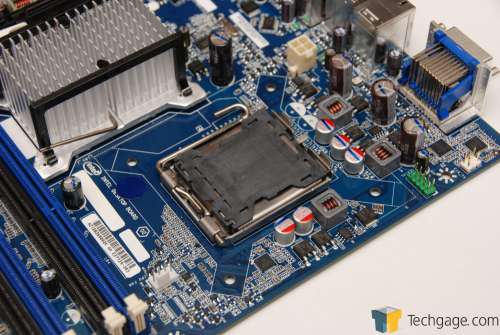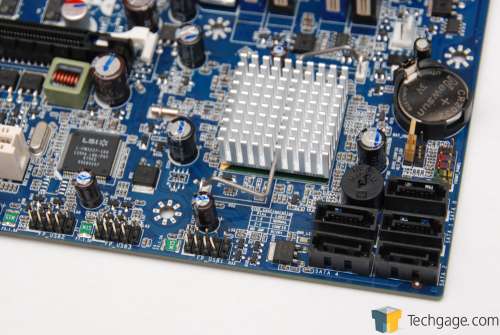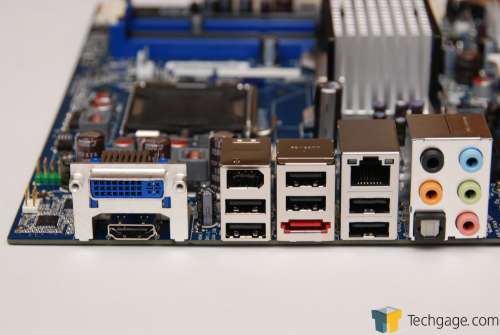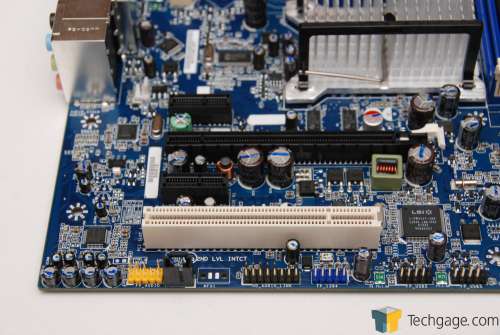- Qualcomm Launches Snapdragon 4 Gen 2 Mobile Platform
- AMD Launches Ryzen PRO 7000 Series Mobile & Desktop Platform
- Intel Launches Sleek Single-Slot Arc Pro A60 Workstation Graphics Card
- NVIDIA Announces Latest Ada Lovelace Additions: GeForce RTX 4060 Ti & RTX 4060
- Maxon Redshift With AMD Radeon GPU Rendering Support Now Available
Intel Desktop Board DG45ID
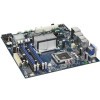
We’re taking a look at Intel’s first attempt at a full-featured media center motherboard, the DG45ID. It’s also our first look at their new G45 Express chipset, which promises to finally bring DX 10 support and hardware-accelerated HD video playback to their integrated graphics offerings. Can the DG45ID prove itself a worthy choice for your HTPC?
Page 2 – First Impressions; Board Layout
The pre-production sample of the Intel DG45ID that we received was so new, it didn’t have a box, I/O shield, any cables, or a even pressed driver disc – it arrived in a foam-padded shipping box, with a CD-R burned with a hodgepodge of driver installers, yet everything that we needed was supplied in one form or another. Unfortunately, at this point, we can’t comment on the final hardware and software bundle that will be included with production motherboards.
The DG45ID motherboard is similar in design to the earlier DG33TL, which featured the G33 chipset with GMA 3100 onboard graphics. It’s manufactured on a deep-blue PCB (a darker shade than Gigabyte’s), and is dominated by a large silver-colored passive heatsink with a plastic retention bridge, mounted over the northbridge. The various structural elements of the board, such as PCI and memory slots, are nicely color-coordinated, in case you’re planning on a windowed case to put your hardware on display, though the overall color scheme is one of the more conservative ones that we’ve recently seen.
As mentioned earlier, this motherboard is positively designed around home theater PC applications, so its Micro ATX form factor enables it to be used in any of the various HTPC-style chassis that use Micro ATX motherboards in order to match the dimensions of most home audio/video equipment. Let’s take a look at a breakdown of the board’s specs and features.
- Form Factor: Micro ATX (9.6″ H x 9.6″ D)
- CPU Socket: LGA 775
- CPU Support: All Celeron 400, Celeron, Pentium, Core 2 Duo, or Core 2 Quad CPUs
- Memory Slots: 4x 240-pin DDR2 (533/667/800) DIMMs, Dual Channel Capable
- Maximum Memory Support: 8 GB total
- Chipset: Intel G45 Express (G45 GMCH, ICH10R Southbridge; “Eaglelake”)
- Audio: 8-Channel Intel High Definition Audio (7.1); IDT 92HD73E audio codec chip
- Audio I/O: 5 analog outputs, one optical (toslink) S/PDIF output
- Video: Intel Graphics Media Accelerator X4500HD onboard with HDMI and DVI+I output
- LAN: Intel 82567LF Gigabit Ethernet Controller, 10/100/1000Mbps
- USB/Firewire: Up to 12 USB 2.0 ports (6 on rear panel), 2 IEEE-1394a (Firewire 400; one on rear panel)
- Storage: Six SATA2 3.0 Gb/s ports (Five internal, one eSATA)
- Other I/O: Consumer IR emitter/receiver (via header), one serial port (via header)
- Expansion Slots: 1x PCIe x16 slot, 2x PCIe x1 slots, 1x PCI slot
- Additional Features: Intel Rapid BIOS Boot, Intel Fast Memory Access, Intel Clear Video Technology, ACPI 2.0, CPU and Chassis fan speed control
Board Layout
There’s very little with the DG45ID that we haven’t already seen when it comes to board layout. In fact, its layout is almost identical to the aforementioned DG33TL G33-based motherboard, with the only differences being in the onboard components used. Here’s another look at the board from the top:
The layout of the Intel DG45ID reflects the company’s years of experience designing motherboards in the cleanliness of its organization. While the level of attention to detail isn’t quite as fanatical as we’ve seen lately from companies like ASUS, and there’s virtually no enthusiast-oriented glitz to speak of, the overall design of the board is very straightforward and practical, with some nice surprises.
At a glance, there don’t appear to be any potential clearance train wrecks for extremely long video cards, and the overall use of space within the Micro ATX form factor’s truncated dimensions is surprisingly effective. From this overhead view of the motherboard, you’ll also notice that there’s plenty of room to reach the retention tabs for all of the memory slots, even with a video card installed – this has been a common complaint with other boards we’ve seen, but the DG45ID offers room to spare.
The DG45ID features four memory slots, arranged in pairs for each individual memory channel. This arrangement is great for installing memory with bulky heatspreaders, since the four sticks aren’t simply packed in together like sardines. It’s also great for airflow if you have only two memory modules installed, since the channels are interleaved – you’ll populate the blue slots first, then the black ones, leaving plenty of room for the modules to breathe.
The LGA 775 CPU socket on the DG45ID leaves plenty of room on all sides for a bulky ‘tower’-style CPU cooler, with the chipset and its bulky heatsink being placed far enough away to still allow space to work with your fingers, even with the board installed in a case. The capacitors near the CPU socket are low-profile, conductive-polymer parts, so they won’t interfere with the mounting systems of most tower-style CPU coolers. Though as always, it’s helpful to double-check your heatsink manufacturer’s motherboard compatibility list before making a heatsink buying decision.
The DG45ID uses a combination of conductive polymer and electrolytic capacitors. The conductive polymer capacitors are used in the output stages of the motherboard’s power supply circuitry, which means that any drift in the effective capacitance values of the electrolytic capacitors on the board won’t affect the quality of the power reaching the CPU.
At the bottom front corner of the DG45ID motherboard, you’ll find five SATA ports. The DG45ID features a total of six SATA2 3.0 Gb/s connectors – the sixth is an eSATA port on the rear panel of the motherboard. There are also three headers for external USB ports, as well as an IEEE-1394a header and an Intel HD Audio header for front-panel audio I/O. The G45 chipset’s southbridge is an ICH10R, which supports RAID 0/1/5/10 configurations. It’s covered by a low-profile aluminum heatsink that won’t interfere with a multi-slot video card cooler.
One thing you’ll notice about the Intel DG45ID’s array of rear-panel ports is that it’s completely free of any ‘legacy’ connections. PS/2, RS-232 (serial), and parallel ports have all been kicked to the curb, though you can still connect an RS-232 port via a header. We’re glad to finally see the move away from outdated interfaces – thus freeing up additional rear-panel space for even more device connectivity.
The DG45ID places its expansion slots a bit differently than we’ve seen in the past. The PCI Express x16 slot is sandwiched in between two PCI Express 1x slots, which means that there’s still room to install a PCI Express 1x card if you’ve got a video card installed that has a double-height cooler. The DG45ID sports a total of four expansion slots, and they’re placed such that you can make use of all four at once, if you use a GPU card with a single-slot cooler.
Now that we’ve taken a closer look at the Intel DG45ID’s layout, let’s delve into its BIOS.
Support our efforts! With ad revenue at an all-time low for written websites, we're relying more than ever on reader support to help us continue putting so much effort into this type of content. You can support us by becoming a Patron, or by using our Amazon shopping affiliate links listed through our articles. Thanks for your support!




